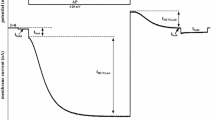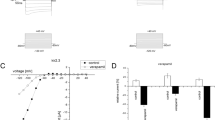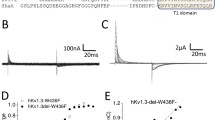Abstract
We analyzed the effects of nifedipine on a family of recombinant low-threshold Ca2+ channels functionally expressed in Xenopus oocytes and formed by three different subunits (α1G, α1H, and α1I). The α1G and α1I channels demonstrated a low sensitivity to nifedipine even in high concentrations (IC50 = 98 and 243 μM, maximum blocking intensity Amax = 25 and 47%, respectively). At the same time, the above agent effectively blocked channels formed by the α1H-subunit (IC50 = 5 μM and Amax = 41%). The nifedipine-caused effects were voltage-dependent, and their changes depended on the initial state of the channel. In the case of α1G-subunits, the blockade was determined mostly by binding of nifedipine with closed channels, whereas in the cases of α1H- and α1I-subunits this resulted from binding of nifedipine with channels in the activated and inactivated states. The obtained data allow us to obtain estimates of the pharmacological properties of the above three subtypes of recombinant channels and, in the future, to compare these characteristics with the properties of low-threshold Ca2+ channels in native cells.
Similar content being viewed by others
REFERENCES
N. S. Veselovskii and S. A. Fedulova, “Two types of calcium channels in the somatic membrane of spinal ganglia neurons of the rat,” Dokl. Akad. Nauk SSSR, 268, 747–756 (1983).
J. R. Huguenard, “Low-threshold calcium currents in central nervous system neurons,” Annu. Rev. Physiol., 58, 329–348 (1996).
N. Hagiwara, H. Irisawa, and M. Kemeyama, “Contribution of two types of calcium current to the pacemaker potentials in rabbit sinoatrial cells,” J. Physiol., 395, 233–253 (1988).
M. F. Rossier, M. M. Burnay, M. B. Valloton, et al., “Distinct functions of T-and L-type calcium channels during activation of bovine adrenal glomerulosa cells,” Endocrinology, 137, 4817–4826 (1996).
X. Xu and P. M. Best, “Increase in T-type calcium current in atrial myocytes from adult rats with growth hormone-secreting tumors,” Proc. Natl. Acad. Sci. USA, 87, 4655–4659 (1990).
C. Arnoult, R. A. Cardullo, J. R. Lemos, et al., “Activation of mouse sperm T-type Ca2+ channels by adhesion to the egg zona pellucida,” Proc. Natl. Acad. Sci. USA, 93, No. 23, 13004–13009 (1996).
E. Tsakiridou, L. Bertollini, M. de Curtis, et al., “Selective increase in T-type calcium conductance of reticular thalamic neurons in a rat model of absence epilepsy,” J. Neurosci., 15, 3110–3117 (1995).
J. R. Huguenard and D. A. Prince, “Intrathalamic rhythmicity studied in vitro: nominal T-current modulation causes robust antioscillatory effects,” J. Neurosci., 14, No. 9, 5485–5502 (1994).
D. A. Self, K. Bian, S. K. Mishra, et al., “Stroke-prone SHR vascular muscle Ca2+ current amplitudes correlate with lethal increases in blood pressure,” J. Vascul. Res., 31, 359–366 (1994).
H. B. Nuss and S. R. Houser, “T-type Ca2+ current is expressed in hypertrophied adult feline left ventricular myocytes,” Circ. Res., 73, No. 4, 777–782 (1993).
R. W. Tsien, D. Lipscombe, D. V. Madison, et al., “Multiple types of neuronal calcium channels and their selective modulation,” Trends Neurosci., 11, No. 10, 431–438 (1988).
P. G. Kostyuk, “Low voltage-activated calcium channels: achievements and problems,” Neuroscience, 92, 1157–1163 (1999).
S. O. Zhuravleva, P. G. Kostyuk, and Y. M. Shuba, “Subtypes of low voltage-activated Ca2+ channels in laterodorsal thalamic neurons: possible localization and physiological roles,” Pflügers Arch., 441, No. 6, 832–93 (2001).
L. L. Cribbs, J. H. Lee, J. Yang, et al., “Cloning and characterization of alpha1H from human heart, a member of the T-type Ca2+ channel gene family,” Circ. Res., 83, No. 1, 103–109 (1998).
J. H. Lee, A. N. Daud, L. L. Cribbs, et al., “Cloning and expression of a novel member of the low voltage-activated T-type calcium channel family,” J. Neurosci., 19, No. 6, 1912–1921 (1999).
E. Perez-Reyes, L. L. Cribbs, A. Daud, et al., “Molecular characterization of a neuronal low-voltage-activated T-type calcium channel,” Nature, 391, No. 6670, 896–900 (1998).
J. H. Lee, J. C. Gomora, L. L. Cribbs, et al., “Nickel block of three cloned T-type calcium channels: low concentrations selectively block alpha1H,” Biophys. J., 77, No. 6, 3034–3042 (1999).
R. L. Martin, J. H. Lee, L. L. Cribbs, et al., “Mibefradil block of cloned T-type calcium channels,” J. Pharmacol. Exp. Ther., 295, No. 1, 302–308 (2000).
C. M. Santi, F. S. Cayabyab, K. G. Sutton, et al., “Differential inhibition of T-type calcium channels by neuroleptics,” J. Neurosci., 22, No. 2, 396–403 (2002).
V. N. Osipenko, V. G. Naidenov, P. G. Kostyuk, et al., “Blocking of cloned low-threshold Ca2+ channels by neuroleptic drugs,” Neirofiziologiya/Neurophysiology, 35, No. 1, 9–18 (2003).
E. Perez-Reyes, “Three for T: molecular analysis of the low-voltage-activated calcium channel family,” Cell Mol. Life Sci., 56, Nos. 7/8, 660–669 (1999).
M. Spedding and R. Paoletti, “Classification of calcium channels and the sites of action of drugs modifying channel function,” Pharmacol. Rev., 44, No. 3, 363–376 (1992).
B. P. Bean, C. J. Cohen, and R. W. Tsien, “Lidocaine block of cardiac sodium channels,” J. Gen. Physiol., 81, No. 5, 613–642 (1983).
K. S. Lee and R. W. Tsien, “Mechanism of calcium channel blockade by verapamil, D600, diltiazem and nitrendipine in single dialysed heart cells,” Nature, 302, No. 5911, 790–794 (1983).
K. Takahashi and N. Akaike, “Nicergoline inhibits T-type Ca2+ channels in rat isolated hippocampal CA1 pyramidal neurons,” Br. J. Pharmacol., 100, No. 4, 705–710 (1990).
C. Romanin, K. Seydl, H. Glossmann, et al., “The dihydropyridine niguldipine inhibits T-type Ca2+ currents in atrial myocytes,” Pflügers Arch., 420, Nos. 3/4, 410–412 (1992).
S. Richard, S. Diochot, J. Nargeot, et al., “Inhibition of T-type calcium currents by dihydropyridines in mouse embryonic dorsal root ganglion neurons,” Neurosci. Lett., 132, No. 2, 229–234 (1991).
W. Stengel, M. Jainz, and K. Andreas, “Different potencies of dihydropyridine derivatives in blocking T-type but not L-type Ca2+ channels in neuroblastoma-glioma hybrid cells,” Eur. J. Pharmacol., 342, Nos. 2/3, 339–345 (1998).
A. N. Tarasenko, P. G. Kostyuk, A. V. Eremin, et al., “Two types of low-voltage-activated Ca2+ channels in neurons of rat laterodorsal thalamic nucleus,” J. Physiol., 499 (Part 1), 77–86 (1997).
N. Akaike, P. G. Kostyuk, and Y. V. Osipchuk, “Dihydropyridine-sensitive low-threshold calcium channels in isolated rat hypothalamic neurons,” J. Physiol., 412, 181–195 (1989).
L. Perchenet, A. Benardeau, and E. A. Ertel, “Pharmacological properties of Ca(V)3.2, a low voltage-activated Ca2+ channel cloned from human heart,” Naunyn-Schmiedeberg's Arch. Pharmacol., 361, No. 6, 590–599 (2000).
P. P. Kumar, S. C. Stotz, R. Paramashivappa, et al., “Synthesis and evaluation of a new class of nifedipine analogs with T-type calcium channel blocking activity,” Mol. Pharmacol., 61, No. 3, 649–658 (2002).
Author information
Authors and Affiliations
Rights and permissions
About this article
Cite this article
Shcheglovitov, A.K., Zhelay, T.I., Kondratskii, A.P. et al. Comparative Analysis of the Mechanisms Underlying Nifedipine-Induced Blockade of Three Subtypes of T-Type Ca2+ Channels. Neurophysiology 36, 93–101 (2004). https://doi.org/10.1023/B:NEPH.0000042560.93321.8c
Issue Date:
DOI: https://doi.org/10.1023/B:NEPH.0000042560.93321.8c




